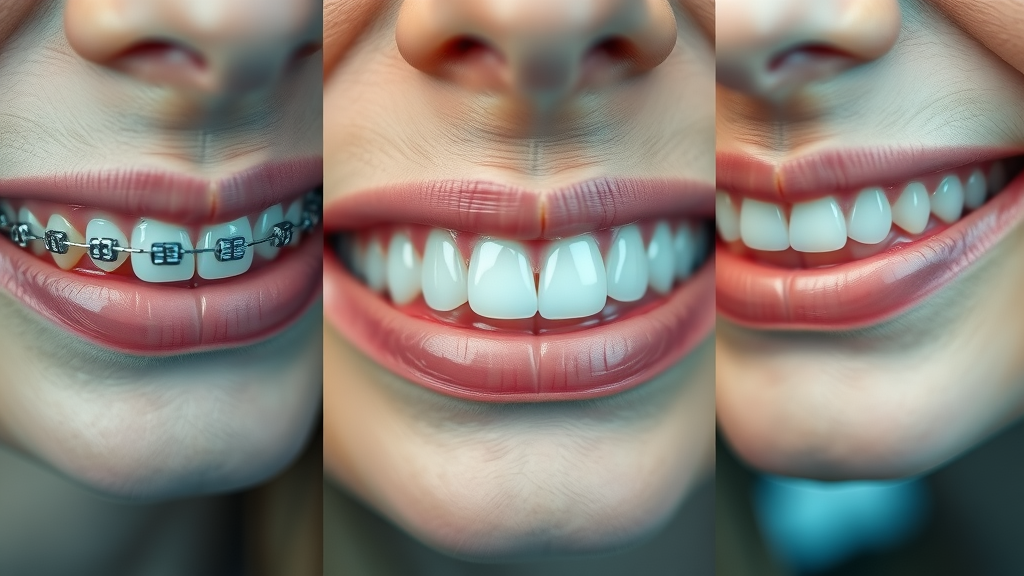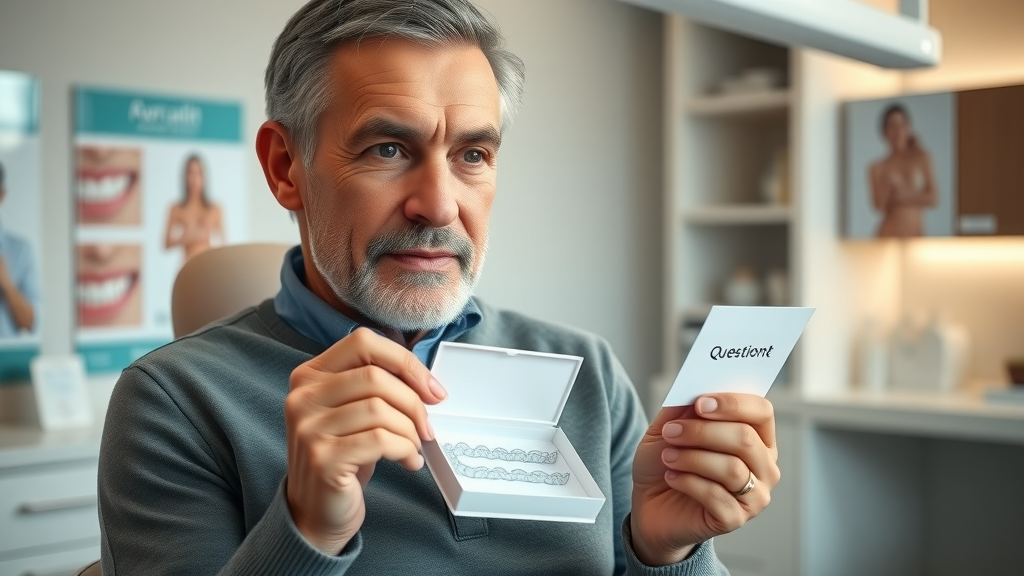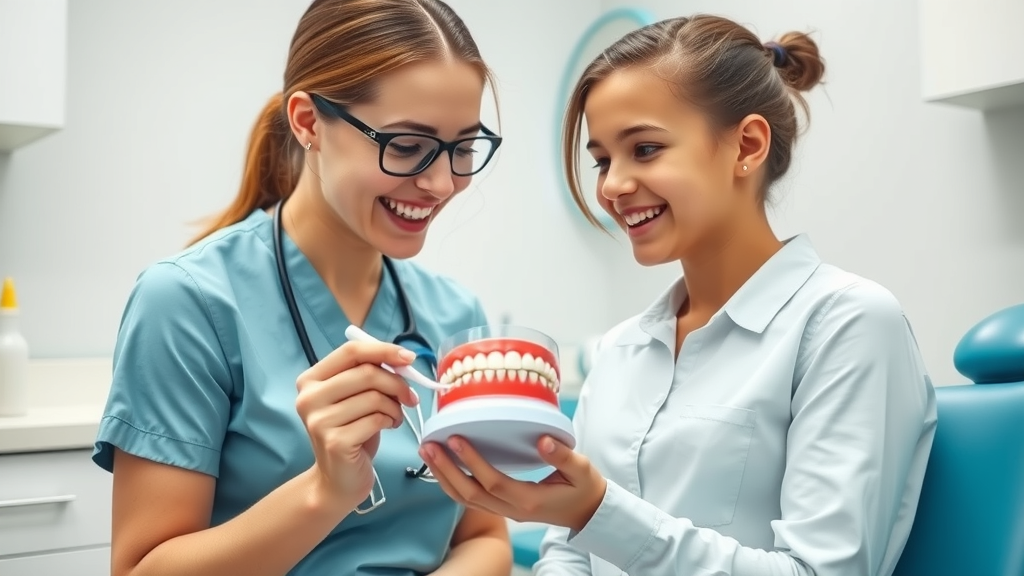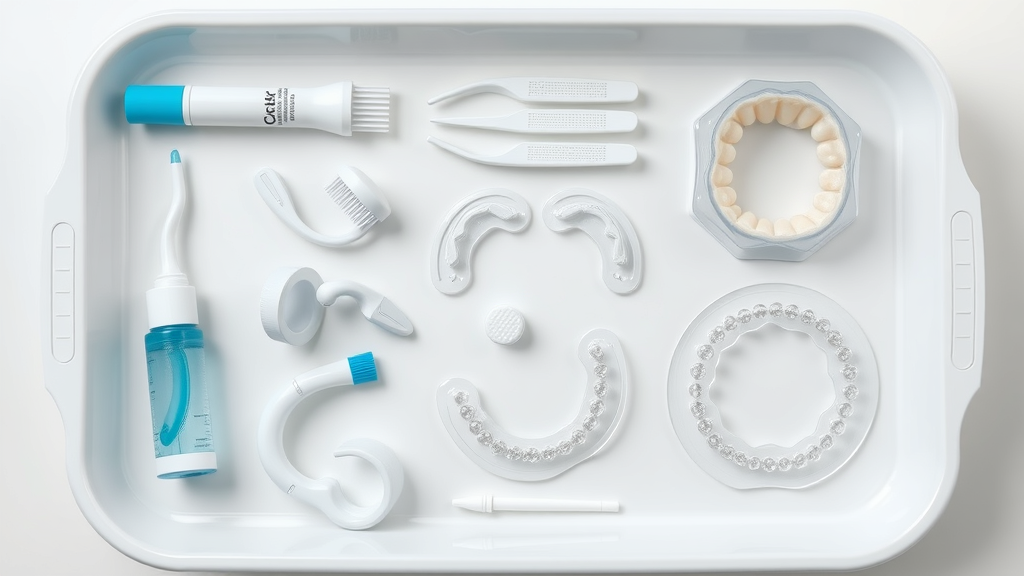Ever wondered which is the right choice for your smile—braces or clear aligners? The most common orthodontic questions have answers that could change how you feel about getting your teeth straight.
Choosing between braces and clear aligners is a big decision that affects your confidence, lifestyle, and oral health. Whether you’re nervous about how you’ll look, concerned about the cost, or unsure about treatment time, this guide collects the top questions patients ask about braces vs. aligners—with clear, easy-to-understand answers to help you make the right move for your smile.
Curious Which is Right for You? Top Questions Patients Ask About Braces vs. Aligners
The decision between traditional metal braces and clear aligners is one every orthodontic patient faces. Both options offer a path to straighter teeth and better bite health, but they come with different benefits, challenges, and expectations. In this article, we’ll answer the top questions patients ask about braces vs. aligners so you can make the best choice—no matter your age, lifestyle, or orthodontic case complexity.
From the look and feel of each treatment, to how they fit your schedule, we’ll break down what to expect from braces or clear aligners. We’ll also share essential advice for everyday care and offer tips straight from orthodontic professionals so you start your journey informed and confident.

“The path to a straighter smile is unique for every patient. Understanding your options is the key to making informed choices.”
What You'll Learn: Key Insights from the Top Questions Patients Ask About Braces vs. Aligners
How to compare braces and aligners for effectiveness and convenience
Common patient concerns about orthodontic treatment
Pros and cons of clear aligners and traditional braces
Oral hygiene and lifestyle adjustments with different options
Key questions to ask your orthodontist
Overview of Orthodontic Treatment: Braces and Clear Aligners
What is Orthodontic Treatment? Comparing Braces vs. Aligners
Orthodontic treatment is designed to move teeth into their desired position, correct bite issues, and improve oral health and confidence. Traditionally, orthodontics focused on metal braces—small metal brackets attached to your teeth and connected with wires. Over the years, clear aligners have offered an alternative: nearly invisible trays custom-fitted to your teeth, gently shifting them through a series of aligner sets.
While both braces and clear aligners can treat mild to moderate alignment issues, they differ in approach and appearance. Braces use brackets and wires to apply steady pressure, making them ideal for complex cases and more challenging tooth movement. Clear aligners, on the other hand, are removable, comfortable, and virtually invisible, appealing to patients who want less noticeable treatment and more flexibility. Understanding these options, along with your orthodontist’s recommendations, helps create a treatment plan that matches your goals.

Why Patients Choose Traditional Braces or Clear Aligners
Traditional braces remain the go-to choice for complex bite problems and severe tooth misalignment cases. They are fixed appliances, so you cannot remove them—something that ensures consistent progress and less temptation to skip wearing them. For patients with challenging orthodontic cases, such as severely crooked teeth, extreme spacing, or bite issues, braces provide predictable and reliable results that have stood the test of time.
Clear aligners appeal to teens and adults who value discretion and convenience. If you’re worried about the appearance of metal brackets, aligners let you straighten your smile almost invisibly. Aligners are also removable for eating, brushing, and special occasions, which many patients love for their flexibility. For those with mild to moderate alignment needs and commitment to wearing aligners for the recommended hours per day (usually 20–22 hours), aligner treatment offers lifestyle-friendly orthodontic care.
Comparison Table: Top Questions Patients Ask About Braces vs. Aligners |
|||
Feature |
Traditional Metal Braces |
Ceramic Braces |
Clear Aligners |
|---|---|---|---|
Visibility |
Highly visible (metal brackets) |
Less visible (tooth-colored) |
Virtually invisible |
Effectiveness |
Best for complex cases |
Effective for most cases |
Best for mild to moderate cases |
Comfort |
May cause irritation |
Smoother, less irritation |
No wires or brackets |
Removability |
No (fixed) |
No (fixed) |
Yes (removable) |
Maintenance |
More oral hygiene challenges |
Similar to metal braces |
Easier hygiene |
Food Restrictions |
Yes |
Yes |
No (remove to eat) |
Treatment Time |
12–36 months |
12–36 months |
6–24 months |
Cost |
Generally lower |
Higher than metal |
Varies, similar to ceramic |
Most Common Questions About Braces or Clear Aligners
Effectiveness: Are Braces or Clear Aligners Better for My Smile?
Spanning decades of orthodontic care, braces have set the gold standard for correcting complex bite issues, severe crowding, and major tooth movement. Metal braces are fixed to the teeth, allowing orthodontists to apply precise adjustments each visit. This hands-on control is why many patients with challenging or orthodontic cases involving significant alignment issues are recommended traditional braces.
However, clear aligners are making impressive strides. For mild to moderate crooked teeth or minor gaps, these transparent trays can realign your teeth quickly and with minimal lifestyle disruption. The key is patient consistency—clear aligners require you to wear them for 20–22 hours per day for best results. Your orthodontist will help you decide which solution fits your treatment plan and desired position for your teeth.

Cost Considerations: Braces vs. Aligners
Cost is one of the first top questions patients ask about braces vs. aligners. Traditional metal braces generally carry a lower upfront price, often making them the choice for those who are budget-conscious. Ceramic braces tend to be slightly more expensive due to their tooth-colored materials. Clear aligners, meanwhile, usually fall in the mid to high price range, depending on the brand, provider, and case complexity, but their convenience and flexibility appeal to many adults.
When factoring in cost, remember to ask your orthodontist about insurance coverage, payment plans, and what’s included in the fee (retainers, adjustments, or emergency visits). For some, the predictability and durability of braces can outweigh the initial savings with aligners. But if virtually invisible treatment and lower maintenance are priorities, clear aligners might justify their higher price tag for you.
Treatment Time: How Long Will Orthodontic Treatment Take?
Treatment time depends greatly on case complexity, your age, and how well you follow instructions. Most traditional metal braces and ceramic braces are worn between 12 to 36 months—longer if your case requires major bite correction or tooth movement. Because braces are fixed, you’ll follow a schedule of checkups and adjustments every few weeks, ensuring steady progress toward your desired smile.
Clear aligners can deliver results faster—sometimes in as little as six months for minor alignment needs, but typically requiring 12 to 24 months. However, aligners only work as planned if worn the prescribed hours per day and changed to each new set on schedule. Missing wear time or delaying transitions between aligner sets can extend your overall treatment time.
Comfort & Appearance: Metal Braces, Ceramic Braces, and Clear Aligners
Comfort and appearance are frequent concerns in orthodontic treatment. Traditional metal braces feature strong brackets and wires, but they can cause initial irritation or soreness inside your cheeks. Ceramic braces are tooth-colored and less visible but may be more brittle. Clear aligners offer a smooth, custom fit and are nearly invisible, making them ideal for patients who want discreet treatment and fewer mouth abrasions.
Traditional metal braces
Ceramic braces
Clear aligners
If a virtually invisible look is your top concern, clear aligners clearly lead the way. However, for dental patients who want the peace of mind that nothing can be mislaid or forgotten, fixed braces (metal or ceramic) set and forget your treatment—at the visible price of shiny brackets and wires.

Oral Hygiene: How to Keep Teeth Clean During Aligner Treatment or Braces
Oral hygiene is vital for every patient, but especially during orthodontic treatment. With braces, brackets and wires create crevices where food and plaque can hide, making brushing and flossing more challenging. Extra attentiveness (and sometimes special cleaning tools) is a must to prevent oral health issues like cavities and gum disease.
In aligner treatment, the ability to remove trays for cleaning arguably makes oral hygiene much easier—provided you’re also brushing and flossing after every meal before popping aligners back in. Whichever option you choose, maintaining excellent oral hygiene and regular dentist visits ensures your hard-earned smile stays healthy and beautiful.
Lifestyle Impact: Eating, Speaking, and Social Life
One major difference between braces and clear aligners is how they affect your daily life. Most types of braces—as well as ceramic options—restrict what you can eat and may impact the way you speak until you get used to them. Sticky, crunchy, or chewy foods could damage brackets and wires, and you’ll need to take care while eating and brushing.
Clear aligners are removable, so you can eat nearly anything you like (as long as you take them out and clean your teeth before reinserting). For concerts, sports, photos, or speaking engagements, being able to temporarily remove your aligners is a huge plus for many lifestyles. Still, remember that the more you remove aligners, the longer your treatment time may become.
Pros and Cons of Braces and Clear Aligners

Pros of traditional metal braces: Highly effective for complex cases, reliable results, ideal for children and teens.
Cons of metal braces: Noticeable appearance, discomfort, food restrictions, and increased cleaning effort.
Pros and cons of ceramic braces: Blend with teeth for lower visibility, but more fragile and may be pricier than metal options.
Pros of clear aligners: Virtually invisible, removable, comfortable, and allow normal eating and oral hygiene.
Cons of clear aligners: Require discipline to wear for 20–22 hours per day, less effective for complex bite issues, may be misplaced or forgotten.
Considering the pros and cons of each option with your orthodontist ensures your treatment plan fits your smile goals and lifestyle demands.
People Also Ask: Top Questions About Braces vs. Aligners
Why do most people choose braces over Invisalign?
Most patients choose braces because of their effectiveness with complex cases and lower maintenance, despite the visibility and comfort of clear aligners.
While clear aligners have soared in popularity for their convenience and discreet appearance, many patients (especially those with severe crowding, big bite problems, or younger children) are recommended traditional braces. Fixed braces require less patient discipline and can resolve more complex orthodontic cases, making them the go-to for predictable, hands-off treatment.
What questions to ask about Invisalign?
Key questions about Invisalign include: 'Is my case suitable?', 'How long will treatment take?', 'Will aligners affect my speech?', and 'How often should I wear them?'
When considering clear aligner treatment, ask your orthodontist if your alignment issues are a good fit for aligners. Find out the expected treatment time, whether aligners will impact your daily speaking or eating routines, and understand how many hours per day you’ll need to wear them. Also, clarify what happens if you lose an aligner and what the maintenance requirements are.

What is the biggest complaint about braces?
The most common complaint about braces is discomfort and difficulty with oral hygiene, followed by food restrictions.
Many patients say metal braces can make your mouth sore—especially after adjustments. Cleaning around brackets and wires may feel tedious and food restrictions (no popcorn or caramel!) can be tough. Still, for the power to move stubborn teeth and fix big bite issues, most agree these trade-offs are worth it for the end result.
What I wish I knew before getting braces?
Patients often wish they knew about potential pain, lifestyle adjustments, and the importance of follow-up appointments before starting braces.
First-time patients are often surprised by the soreness after getting or adjusting metal braces—it usually fades, but it’s good to be prepared. Keeping up with strict oral hygiene, sticking to orthodontic-friendly foods, and showing up for every check-up are key to a smooth treatment (and faster, happier results).
Orthodontist Explains Top Questions Patients Ask About Braces vs. Aligners
Expert Insights: Answers to the Top Questions Patients Ask About Braces vs. Aligners
"Every patient deserves a treatment that matches their lifestyle and goals." — Dr. J. Carter, Orthodontic Specialist
Orthodontists agree: the right treatment for you balances your dental needs, daily habits, and future plans. No two patients are alike—so ask about expected results, maintenance, and any lifestyle impacts before committing. Being open with your provider ensures you get answers tailored to your orthodontic treatment priorities.
For the best outcomes, follow your prescribed treatment plan, attend check-ups, and never hesitate to voice new concerns or challenges as they arise. Staying proactive and informed leads to a happier, healthier smile.
Best Practices: Oral Hygiene and Care During Orthodontic Treatment
Tips for Brushing and Flossing with Braces or Aligners
Daily oral hygiene should not slip while you’re in braces or aligners—if anything, it’s even more important! Use a soft-bristled toothbrush and fluoride toothpaste to gently clean all surfaces of your teeth, focusing on the spots around brackets and wires for braces. If you have clear aligners, brush your teeth (and aligners!) after every meal to prevent staining and bacteria buildup.
Flossing with braces becomes easier with floss threaders or orthodontic flossers. For aligners, regular flossing means removing trays first. Some skilled hygienists recommend water flossers for patients with lots of dental work. Ask your dental team for personalized techniques to maintain healthy gums and teeth throughout care.

Top Products for Maintaining Oral Hygiene with Orthodontics
The right tools make a world of difference. Consider investing in:
Orthodontic toothbrushes (angled bristles get around brackets)
Interdental brushes or soft picks for tight spaces
Floss threaders or orthodontic flossers for braces
Antimicrobial mouthwash to cut down bacteria
Retainer and aligner cleaning crystals for clear aligners
Water flossers for a thorough, gentle clean
Using these products every day can make oral hygiene a breeze—no matter your chosen orthodontic treatment.
Watch this expert video for quick demonstrations on best practices to clean braces and clear aligners—and keep your smile sparkling throughout treatment!

FAQs: More Top Questions Patients Ask About Braces vs. Aligners
Does insurance cover braces or clear aligners? Many dental plans cover a portion of orthodontic treatment for patients under 18, but coverage varies—always ask your provider.
Can I switch from braces to aligners during treatment? Sometimes, yes—if your case allows. Talk with your orthodontist about transitioning as your teeth progress.
What foods should I avoid? With braces: sticky, crunchy, hard, and chewy foods. With aligners: remove trays to eat, then clean teeth before reinserting.
How often do I need orthodontic check-ups? Usually every 4–8 weeks for braces, and every 6–12 weeks for clear aligners—or as advised for your treatment plan.
How noticeable are ceramic braces compared to metal braces? Ceramic braces are less visible, blending in with the color of your teeth, but may still show compared to clear aligners, which are virtually invisible.
Key Takeaways: What to Remember from Top Questions Patients Ask About Braces vs. Aligners
Braces are typically preferred for complex corrections
Clear aligners offer discretion and removable convenience
Cost, appearance, and lifestyle impact are key considerations
A personalized consultation is crucial
Conclusion: Informed Choices from the Top Questions Patients Ask About Braces vs. Aligners
Choosing between braces or aligners is a significant step—make sure all your top questions are answered before starting your orthodontic treatment.
Ready for Your New Smile? Stay Up to Date on Braces vs. Aligners
Your smile is worth it — and staying informed is the first step. Join hundreds of locals already following Grand Strand Smile Spotlight for updates, advice, and trusted care insights.
Subscribe now to get the latest Grand Strand orthodontic guides, tips, and updates — right to your inbox. No spam. Just smiles.
Want more expert-backed answers about braces, Invisalign, and local orthodontic care? Subscribe to Grand Strand Smile Spotlight and stay ahead of your smile journey.
When considering orthodontic treatment, it’s essential to understand the differences between traditional braces and clear aligners. The article “Top Questions Patients Ask About Braces vs. Aligners” provides comprehensive insights into this topic.
For a deeper understanding, the article “Top 5 Questions Patients Ask About Orthodontic Treatment” from Brunswick Valley Orthodontics addresses common concerns such as the best age to start treatment, duration, and the differences between braces and Invisalign. This resource can help clarify your options and set realistic expectations.
Additionally, “Questions to Ask Before Getting Braces or Invisalign” by Love Orthodontics offers essential questions to consider before beginning your orthodontic journey. It covers treatment options, costs, and how braces or aligners may impact your daily life, ensuring you’re well-prepared for the process.
If you’re serious about achieving a straighter smile, these resources will provide valuable information to guide your decision-making process.
 Add Row
Add Row  Add
Add 




Write A Comment